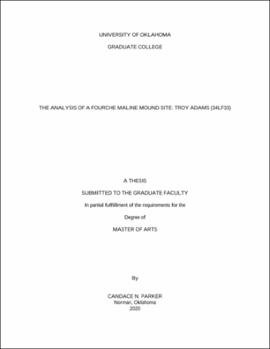| dc.description.abstract | The Fourche Maline archaeological culture is a group of people that have constructed a series of mound sites that are located along the Fourche Maline creek in eastern Oklahoma with other similar sites in Arkansas, Louisiana, and Texas. The Fourche Maline archaeological culture is identified by the large dark-earth mounds, distinct ceramic wares, varieties of Gary points and presence of various bone and stone tools. A large number of these mounds were excavated in the 1930s and 1940s by the Works Progress Administration. Many of these sites were to be destroyed by the construction of Lake Wister and in order to prevent the complete loss of important cultural resources, many Fourche Maline sites were excavated. After the excavations were complete, very little analysis of those collections were conducted. Over the years, various sites received material analysis, but many continue to go unanalyzed. This thesis presents an analysis of materials collected from the Troy Adams site – 34LF33 – one of the sites that has received very little, if any analysis and interpretation.
In order to gain a better understanding of how this site fits into the broader ideas of Fourche Maline, a landscape approach is taken. This approach will help to encapsulate both the physical setting of these sites on the landscape while also accounting for the human influence on that environment and the things that took place on that landscape, especially with regard to the tools that they used and the activities in which they participated.
In addition to presenting a material analysis, this thesis will also take a comparative look at what other sites identified as Fourche Maline look like and how these general ideas about Fourche Maline compare to what was found at Troy Adams (34LF33). The main question that I will be addressing for this research is regarding the use and significance of the landscape in which these sites are located. It is my goal to gain a better understanding of what the artifacts can tell us about the landscape and how it was being used and manipulated by people in the past. I will also answer questions about the production and use of ceramic materials, the acquisition of raw materials for stone tools and the uses of those stone tools; this will all tie into landscape usage.
This thesis demonstrates that Troy Adams (34LF33) was part of a series of mound sites along the creek that depict landscape modification. Through an examination of archaeological materials, I conclude that this area and these sites were highly modified by the people in the past that occupied them. They were only constructing and mounds and burying their dead within them, but they prepared the landscape for cultivation, manufacturing tools and other daily lifestyle activities. | en_US |
